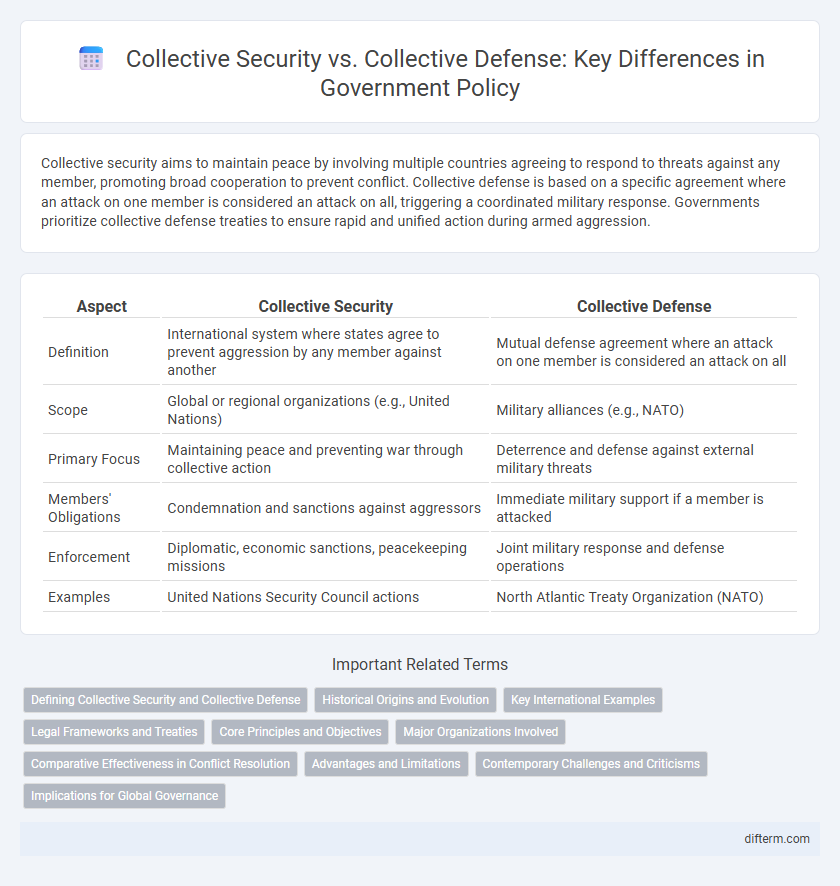Collective security aims to maintain peace by involving multiple countries agreeing to respond to threats against any member, promoting broad cooperation to prevent conflict. Collective defense is based on a specific agreement where an attack on one member is considered an attack on all, triggering a coordinated military response. Governments prioritize collective defense treaties to ensure rapid and unified action during armed aggression.
Table of Comparison
| Aspect | Collective Security | Collective Defense |
|---|---|---|
| Definition | International system where states agree to prevent aggression by any member against another | Mutual defense agreement where an attack on one member is considered an attack on all |
| Scope | Global or regional organizations (e.g., United Nations) | Military alliances (e.g., NATO) |
| Primary Focus | Maintaining peace and preventing war through collective action | Deterrence and defense against external military threats |
| Members' Obligations | Condemnation and sanctions against aggressors | Immediate military support if a member is attacked |
| Enforcement | Diplomatic, economic sanctions, peacekeeping missions | Joint military response and defense operations |
| Examples | United Nations Security Council actions | North Atlantic Treaty Organization (NATO) |
Defining Collective Security and Collective Defense
Collective security is a global or regional arrangement where multiple states agree to respond together to threats against any member, aiming to maintain peace and prevent aggression through joint diplomatic, economic, or military measures. Collective defense, in contrast, is a specific alliance-based commitment where members pledge to defend one another militarily if attacked, as exemplified by NATO's Article 5 principle. Understanding the distinction involves recognizing collective security as a broader peacekeeping mechanism, while collective defense centers on mutual defense against armed aggression.
Historical Origins and Evolution
Collective security emerged in the aftermath of World War I, epitomized by the League of Nations' attempt to prevent aggression through broad international cooperation and legal frameworks. Collective defense developed later, primarily through military alliances such as NATO, focusing on mutual defense commitments against external threats. This evolution reflects a shift from idealistic global peace enforcement toward pragmatic, alliance-based deterrence during the Cold War era and beyond.
Key International Examples
Collective security frameworks, as demonstrated by the United Nations, emphasize broad international cooperation to prevent aggression and maintain peace through collective responses to threats. In contrast, collective defense agreements like NATO's Article 5 establish a formal commitment among member states to respond militarily if one is attacked, focusing on mutual protection. Key international examples highlight the UN Security Council's role in enforcing global peace versus NATO's operational focus on deterrence and defense among Western allies.
Legal Frameworks and Treaties
Collective security is established through broad multilateral treaties like the United Nations Charter, which obligate member states to maintain international peace by addressing threats collectively and often through diplomatic or economic measures. Collective defense is typically codified in regional alliances such as NATO's North Atlantic Treaty, which legally binds members to respond militarily if one party is attacked. Legal frameworks differ in scope and enforcement mechanisms, with collective security emphasizing universal jurisdiction and collective defense focusing on mutual military support among specific members.
Core Principles and Objectives
Collective security emphasizes the prevention of aggression through a unified response by all member states, aiming to maintain international peace and deter conflicts globally. Collective defense focuses on mutual protection, where an attack against one member is considered an attack against all, ensuring immediate and coordinated military support. Core principles of collective security include inclusivity and conflict resolution, while collective defense centers on alliance solidarity and rapid defense mobilization.
Major Organizations Involved
Major organizations involved in collective security include the United Nations (UN), which aims to maintain international peace through diplomatic efforts and peacekeeping missions. Collective defense primarily involves military alliances such as the North Atlantic Treaty Organization (NATO), which commits member states to mutual defense in response to an armed attack. The Organization of American States (OAS) and the African Union (AU) also play significant roles in regional collective security and defense frameworks.
Comparative Effectiveness in Conflict Resolution
Collective security systems, as exemplified by the United Nations, emphasize multilateral cooperation to prevent aggression through collective political and economic pressures, often achieving broader conflict resolution by addressing underlying causes. Collective defense alliances, such as NATO, provide rapid, coordinated military responses that effectively deter direct attacks but may escalate conflicts due to their rigid defense commitments. Comparative effectiveness in conflict resolution reveals that collective security promotes diplomacy and conflict prevention on a global scale, whereas collective defense ensures immediate military deterrence, with each approach suited to different stages and types of international threats.
Advantages and Limitations
Collective security enhances international stability by promoting broad cooperation among states to prevent aggression, reducing the likelihood of conflicts through unified diplomatic and economic measures. Its advantage lies in fostering inclusive security arrangements that deter threats before escalation, but it faces limitations due to varying national interests and the challenge of rapid consensus among diverse members. Collective defense offers a clearer, immediate response mechanism through mutual military support among allies, yet its effectiveness can be constrained by rigid alliance commitments and the risk of entanglement in localized disputes.
Contemporary Challenges and Criticisms
Collective security faces challenges in achieving unanimous international cooperation due to divergent national interests and the complexity of addressing non-traditional threats like cyber warfare and terrorism. Collective defense mechanisms, exemplified by NATO, are criticized for escalating regional tensions and creating dependency among member states rather than encouraging autonomous defense capabilities. Both frameworks struggle with balancing rapid response and respect for sovereignty amid evolving global security dynamics.
Implications for Global Governance
Collective security, rooted in universal cooperation against aggression, promotes inclusive global governance frameworks fostering international law and multilateral institutions. Collective defense, centered on alliance commitments like NATO, emphasizes mutual military support, potentially reinforcing regional blocs but risking fragmentation in global decision-making. Balancing these approaches influences state sovereignty, conflict resolution mechanisms, and the effectiveness of global governance in maintaining peace and security.
collective security vs collective defense Infographic

 difterm.com
difterm.com